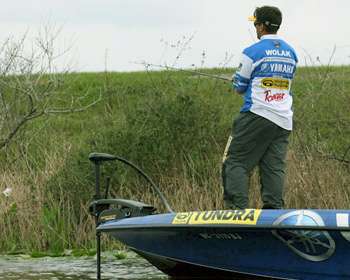
When four-time Bassmaster Classic qualifier Dave Wolak sees matted grass, he's in his comfort zone. At times, he seems so in tune with heavy vegetation bass that it's almost as if he can see what's going on under the canopies. But he's not Superman.
Even though he wears quality polarized sunglasses and has the best marine electronics money can buy on his boat, his entry into the Elite Series didn't grant him an X-Ray vision starter set. Instead, he has learned to use subtle clues and multiple senses to figure out what lies beneath the surface and in turn he makes those observations work for him on tournament days.
First, he uses his sense of sight: "I want to find a hard bottom, like gravel or rock," he says. "In places like Florida, it may just be finding sand versus muck. So right off the bat, if the mat is adjacent to any shoreline, I check what kind of bottom is there and see if it continues out into the water."
Second, he uses his sense of touch, especially if he's fishing away from shore. "A trick I use is to stick the tip of my rod down to get a feel for the bottom," he explains. Third, he uses his sense of smell: "If you turn around with the trolling motor and you churn the bottom and get that sulphury, muck smell, that's a big no-no to me," he says.
"That's blown-in sediment or rotted wood and I hardly ever do any good fishing around that stuff, unless the other variables — such as ideal temperatures — are overwhelming." He also looks to see if the mats are likely to form a canopy. Super-shallow grass on tidal waters or on lakes where the water level has fallen may be too dense for a bait to get through, even a bait weighted down with a 1 1/2-ounce sinker. "The ability to penetrate a mat is very important," he cautions.
This often allows him to narrow down the key strike zones. Wolak also cautions anglers not to assume that grass is in the same stage of growth throughout a given waterway. Particularly in northern latitudes, where he learned to fish, grass may grow sooner in some places, but thrive later in the year elsewhere. Late in the season, the key is to avoid the dead stuff. "If you find a place where the slime chokes the oxygen out of it, you probably will catch nothing," he says.
"You want to find the good, green, living non-slimy mats." The final element he seeks out is current. If a corner of a mat lies adjacent to the flow, many times it will be greener. And if there's a decent population of fish living in proximity to the mat, that corner will likely outproduce the rest of the mat.
You may never get to see what actually exists beneath the grass you're fishing, but you don't need to see it to understand how it lays out and why it holds fish.
(Provided by Z3 Media)





